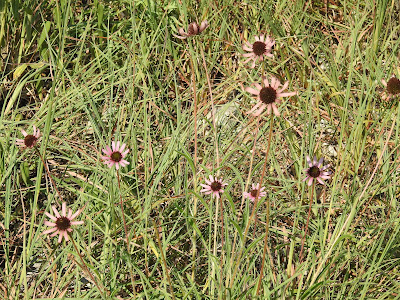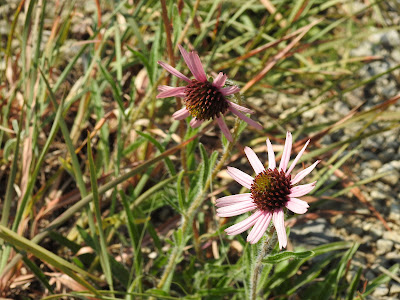Country music may have made Nashville famous, but rock makes it special.
Limestone underlies much of the area around Nashville, and to the south and east especially tends to be found at or just below the surface. Some of these outcroppings have become known as cedar glades—in a region otherwise dominated by hardwood forest, the thin soil of cedar glades supports a prairie-like plant community in which eastern red cedars are the only significant trees. Cedars normally invest most of their early growth in a deep taproot, followed by an extensive network of shallow roots; in rocky sites with shallow soil, the taproot can grow horizontally, allowing cedars to thrive where hardwood trees cannot.
During the last Ice Age, when central Tennessee was cooler and drier and supported a prairie plant community, an Echinacea—maybe pallida, more likely angustifolia or a species ancestral to it—colonised the limestone outcroppings, able to survive in the shallow soil by extending a deep, narrow taproot through cracks in the underlying limestone. Over time this Echinacea became exquisitely adapted to its new habitat, and when the climate shifted again and hardwood forest succeeded prairie, it persisted in the sunny openings of the cedar glades through the wet springs and punishingly hot, dry summers. In isolation from other Echinacea populations, it eventually took on its own identity, a classic example of allopatric speciation.
But specialisation is a double-edged sword, and by virtue of its narrow niche Echinacea tennesseensis was bound to be a rare flower. It wasn’t formally described until 1898, and by the middle of the 20th century it was thought to be extinct.
That changed in 1968, when the species was rediscovered by Vanderbilt botanist Elsie Quarterman and grad student Barbara Turner. Conservation efforts began almost immediately, spearheaded by Quarterman, and the Tennessee coneflower was listed as an endangered species at the federal level in 1979. The Nature Conservancy purchased the land where Quarterman and Turner had found their coneflowers, and other tracts where the energised botanists found additional colonies. With the existing colonies thus protected from rampant development and some new ones established (or re-established) in suitable habitat, tennesseensis was delisted in 1991; Elsie Quarterman, age 101, attended the delisting ceremony. The Nature Conservancy sites have been transferred to the Tennessee Department of Environment and Conservation to be managed as State Natural Areas.
Owing to a misunderstanding, Jessa and I missed the Mount View Cedar Glade where Dr. Quarterman made her fateful rediscovery, but we visited two other coneflower sites on a hot, sunny day in mid-July. The first was Couchville Cedar Glade near Rural Hill, Tennessee. (The eponymous town of Couchville no longer exists, having been inundated when the Stones River was dammed to create Percy Priest Lake in the 1960s.)
Our other site was Vesta Cedar Glade near the unincorporated community of Gladeville.
One thing we realised right away is that the coneflowers in our garden—lush and easily three feet high—have it easy. Their wild counterparts, living in near-desert conditions, topped out at about a foot tall. But they are possessed of a tough beauty and the rightness that comes with authenticity. And with tennesseensis now in widespread cultivation, I would recommend anyone else trying the species for the first time plant their flowers in full sun in a rock garden...they can take it.
Photos by Mark & Jessica Farrell-Churchill. Just a few more?






































No comments:
Post a Comment